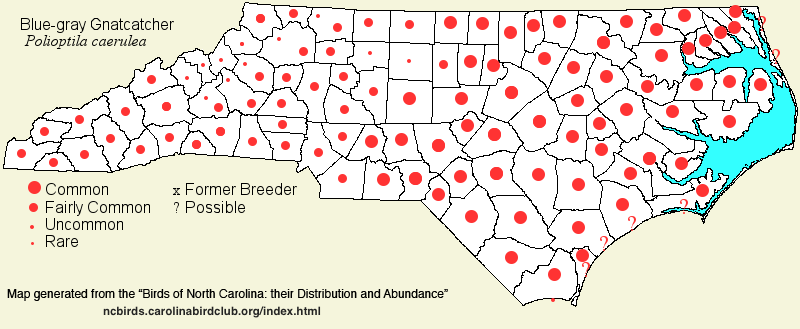 |  |
|
Blue-gray Gnatcatcher - Polioptila caerulea Sole representative of POLIOPTILIDAE in NC | Search Common: Search Scientific: |
|
|
|||||||
| General Comments | The Blue-gray Gnatcatcher is the only member of its small family found in the eastern half of the continent. It is barely larger than the two kinglets, though it has a completely different range and habitats from them. The gnatcatcher is a characteristic bird of hardwood forests, preferably moist ones, but it does nest in dry hardwood and mixed forests, as well. It nests over the entire state, though it can be hard to find in some of the higher mountain counties (in the north). It also winters over much of the Atlantic and Gulf coastal plains, with the northern end of its range in coastal North Carolina. In winter, it favors broadleaf evergreen forests, such as maritime forests, or mixed-pine hardwood forests. Because of generally warmer than usual winters over the past several decades, winter survival has increased, and the overall species population appears to be slightly increased. Certainly, its winter range and population in the state has increased, though it is still uncommon and often a good find on CBC's. | ||||||
| Breeding Status | Breeder | ||||||
| NC BRC List | Definitive | ||||||
| State Status | |||||||
| U.S. Status | |||||||
| State Rank | S5B,S2N | ||||||
| Global Rank | G5 | ||||||
| Coastal Plain | Summer resident regionwide, and a sparse winter resident in part of the region. Common (to locally very common) and widespread in summer, though can be scarce on some coastal islands. In winter, uncommon (slightly increasing) along the southern coast, where some birds undoubtedly survive the winter. Rare to uncommon in early winter as far north as the central coast and the Lake Mattamuskeet area, and rare elsewhere along the northern coast and Tidewater; overwintering unlikely. Farther inland in winter, very rare to rare, mainly in early winter, and not likely overwintering. Mainly mid- or late Mar into Oct. Peak counts: | ||||||
| Piedmont | Summer resident, with stragglers into winter. In summer, generally common to at least locally very common, over the region, presumably slightly less numerous in the foothills. Rare in early winter, mainly in the eastern and southern portions, but very few likely survive the winter. Mainly late Mar to late Sep, though many records into early Jan. Peak counts: 394, Jordan Lake spring count, 7 May 2000. | ||||||
| Mountains | Summer resident. Fairly common in lower elevations, at least in broad valleys below 2,500 feet; uncommon to fairly common to about 3,500 feet; rare to 4,000 feet. Mainly late Mar to mid-Sep. One midwinter record -- one seen and photographed at Lake Junaluska (Haywood), 15 Dec 2016 and again 5-11 Jan 2017. Another was notable at Mills River Park (Henderson) on 31 Dec 2019, as was one in far northern Watauga, where photographed at Boone on 15 Dec 2023. Peak counts: | ||||||
| Finding Tips |
None needed. **** | ||||||
| Attribution | LeGrand[2024-05-14], LeGrand[2023-03-27], LeGrand[2020-04-18] | ||||||
| NC Map Map depicts all counties with a report (transient or resident) for the species. | Click on county for list of all known species. |
| NC Breeding Season Map Map depicts assumed breeding season abundance for the species. |  |